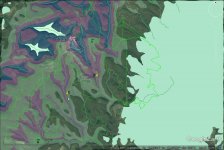geology, acid rain/deposition, and trout:
http://swas.evsc.virginia.edu/publications/Current-and-Projected-Status.pdf
"1. The source of the acid: fossil fuels
The burning of fossil fuels releases sulfur and nitrogen
oxides into the atmosphere, where they are converted
to sulfuric and nitric acids. These acidic materials
may be transported long distances in the atmosphere
before they are deposited in wet or dry
form on landscapes.
2. Landscapes differ in sensitivity, based on geology.
Whether or not acidic deposition produces negative
effects on the animals living in streams and lakes
depends largely on the bedrock geology of their
catchments. In landscapes underlain by limestone
(carbonate bedrock), which provides substantial
buffering of acidity, negative effects due to acidification
are neither expected nor seen in water bodies.
Basaltic, granitic, and siliciclastic (such as sandstone)
bedrock types represent a series of decreasing
levels of buffering capacity, such that modest
amounts of acidic deposition produce conspicuous
negative effects in sandstone catchments.
Catchments composed of multiple bedrock types
naturally show intermediate degrees of sensitivity to
acidification, dependent on available local buffering
capacity. Since buffering capacity ultimately depends
on the weathering of acid-neutralizing material
from the bedrock, hard bedrock types produce
less buffering capacity for streams than soft bedrock
types. Mountains by their very nature are more resistant
to weathering than surrounding lowlands
(that’s why the mountains are still there), so mountain
streams and lakes are usually the most sensitive
to acidification due to the lower weathering rate and
buffering capacity of their catchments. In contrast,
large valley streams and lakes are the recipients of
upstream weathering products, and are often less
sensitive to acidification as the result of their greater
buffering capacity.
If the bedrock types underlying a given landscape
unit are a heterogeneous mixture in terms
of their acid-neutralizing capacity, there will be
different responses among the water bodies and
fish communities, even under identical acidic
deposition regimes.
3. The role of aluminum: metabolic poison
Aluminum is the most abundant metal on the
earth’s surface, and the third most abundant element.
It is non-toxic and insoluble under acid-neutral
conditions, but very toxic to fish and other
aquatic species under acidic conditions. Unfortunately,
the solubility of aluminum increases exponentially
as pH falls below 5.6; its maximum toxicity
occurs at about pH 5.0. The deposition of acids
results in the release of aluminum from soils and its
transport in solution to streams and lakes. Both the
aluminum and the hydrogen ion (derived from sulfuric
and nitric acids) are toxic to fish, but in most
streams and lakes the aluminum is the primary
lethal agent; fish can survive more acidic conditions
(i.e., lower pH) in the laboratory in the absence
of aluminum.
4. Site of toxic action: fish gill
The site of the toxic action of both the hydrogen
ion and aluminum is the fish gill. The gill is a complex
organ responsible for oxygen and carbon dioxide
exchange, as well as maintaining the proper salt
and water balance in the fish’s body. It is this latter
function which is always compromised by acid and
aluminum stress; respiration is also compromised at
higher concentrations of aluminum.
Freshwater fish maintain salt (sodium chloride)
in their blood at concentrations similar to those in
humans and most other vertebrates. The proper
functioning of most body cells, and especially blood
cells in this context, depends on keeping salt concentrations
in body fluids within rather narrow limits.
Since salt concentrations in the blood are much
higher than the water in which they swim, fish constantly
lose a small amount of sodium and chloride
from the blood by passive diffusion across the thin
skin of the gills. The lost sodium and chloride are
replaced by an energy-requiring process (active
transport) using biochemical “pumps” in the gill
membranes which transport sodium and chloride
from low concentration in the external stream water
to higher concentration in the blood.
Aluminum and hydrogen ions poison the biochemical
pumps which transport sodium and chloride
into the body; they also weaken the junctions
between gill cells, making them leak more sodium
and chloride than they otherwise would. The rapid
loss without replacement of sodium and chloride
produces a cascade of negative physiological effects
in the fish’s body."




